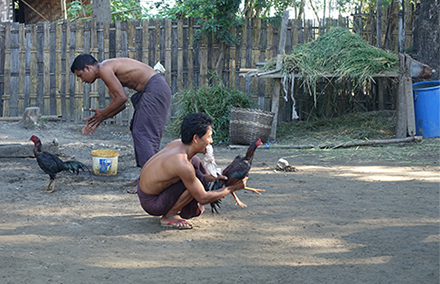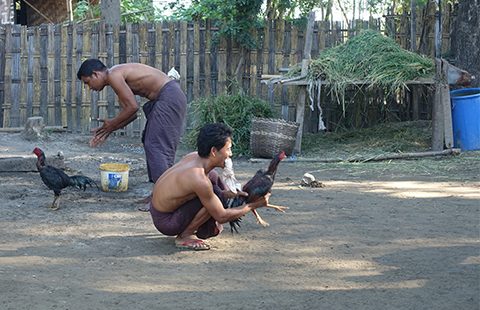
Photo: Olivia Cable
For Southeast Asianists, cockfighting is commonly associated with Bali. Writings about cockfights in Myanmar are as rare as hen’s teeth.
And since Naypyitaw is known for its highways, hotels and parliaments, the practice of cockfighting is unheard of in Myanmar’s capital. So to come across a brutal brawl of the bantams in Naypyitaw felt like a major discovery.
On the eve of the 8 November election, I arrived in a village that was in the middle of a match: two men, two cocks, and an audience of some 20 onlookers.
In Clifford Geertz’s classic essay Deep play: Notes on the Balinese cockfight he explains that “everyone ignored us in a way only a Balinese can do” and that “people seemed to look right through us with a gaze focused several yards behind us”. This was the case in Naypyitaw: no one greeted me and nobody seemed to be irritated by my presence.
The day started out by following political rallies in Naypyitaw’s townships. As I detoured into Pyinmana’s paddy fields, I stumbled across a cemetery at the entrance of a village. Tombstones stood firmly cemented into the ground. Most faced a westerly direction, others took their own direction, being somewhat off-centre.
I was guided down the village’s main street by political party campaign posters: notably Union Solidarity and Development Party and the National League for Democracy. Women stood at the front of their homes, holding their children in arms.
But the eve of the election wasn’t the hype in the village; it was the compound where the cockfight was playing out.
The crowd was intimate. As I stood behind a throng of men, by no stretch of the imagination was this a shallow affair. As a foreigner walking into the compound, few people looked at me. Their eyes were firmly focused on the two men and their cocks.
Time and again, a cock’s head would get trapped between the legs of it’s opponent. Both cocks would stand frozen, until it was released from the headlock. The two men would stand behind their cocks, crouching down to an even level.
Each round would last for no more than five minutes. To spur their cocks on, the men would cup water into their mouths from a bucket at the rim of the ring. Delicately walking over to their fighting cocks, the men would bend over and spray the water from their mouths into the cock’s face.
At the end of each round, the men would lift their cocks from the ground. With a white cloth, they’d dab the cock’s bodies and bloodied neck. The men would energise their cocks by blowing into their cupped hands, and then pressing into the legs and body of their cocks.
I didn’t stay till the end of the cockfight – each round become more savage.
Thankfully, there wasn’t a raid in the village.
To quote Clifford Geertz, cockfighting “brings together themes–animal savagery, male narcissism, opponent gambling, status rivalry, mass excitement, blood sacrifice–whose main connection is their involvement with rage and the fear of rage”.
As the cockfight in Naypyitaw highlights, traditional forms of society play out among the city’s peoples. No doubt, many aspects will change.
But understanding the ways of life of the first people in Naypyitaw is critical as the capital enters its next phase.
Olivia Cable is a research assistant in the Coral Bell School of Asia Pacific Affairs, the Australian National University.
Watch a short video clip from the cockfight in the player below.
 Facebook
Facebook  Twitter
Twitter  Soundcloud
Soundcloud  Youtube
Youtube  Rss
Rss 